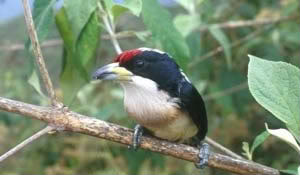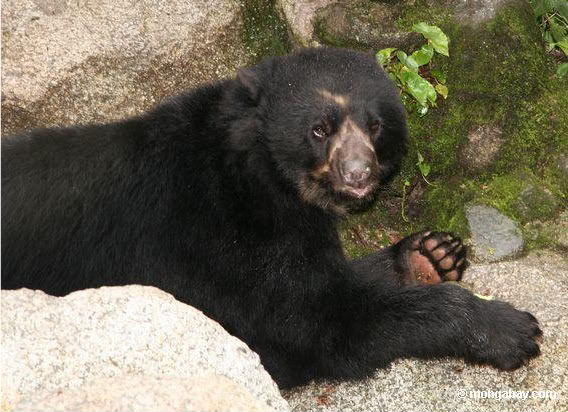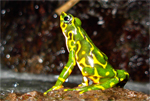|
|
Serrania de San Luca is a rainforest-covered massif rising to 2,300 meters (7,500 feet) in northern Colombia. Despite being little-explored and containing several endangered species, the forest is threatened by industrial gold mining operations, according to the local conservation group ProAves.
Already the forest has been reduced to 10 percent of its original 2.5 million acres due to agriculture, small-scale mining, and other human impacts. Now, the Colombian government has granted large concessions to AngloGold Ashanti, a gold mining company out of South Africa which has been criticized by the Human Rights Watch for allegedly aligning itself with locally armed gangs in the Democratic Republic of Congo.
 The Serranía de San Lucas. Photo courtesy of ProAves Colombia. |
“To hand over the Serranía de San Lucas to mining companies is not only irresponsible but represents a potential catastrophe to Colombia and the planet,” ProAves writes in an announcement related to the gold-mining concessions. “Serranía de san Lucas is a biodiversity treasure that Colombia and the world should be proud of. Unfortunately, none of the mining companies support the protection of biodiversity and sadly, not a single hectare of the San Lucas massif is protected for biodiversity conservation.”
The only survey done on the Serrania de San Lucas massif was conducted by ProAves from 1999-2001. The organization recorded 374 bird species, eleven of which are considered threatened by the IUCN, including the Critically Endangered blue-knobbed currasow (see list at the end of the article).
 Map of Serranía de San Lucas showing forest cover (left) with surviving forest (dark green), cleared forest (gray) and recent deforestation (light green) and mining concessions (right) with mining rights in red. Source: Ingeominas 2009. Graph courtesy of ProAves Colombia. |
They also found endangered mammals, including the spectacled bear, the silverybrown bare-face tamarin, and the white-fronted capuchin monkey, all classified as Vulnerable by the IUCN. Jaguars, considered Near Threatened, were also present. Due to the nature of the survey, the researchers did not look at bats or rodents, the most diverse mammals in the rainforest. In addition, the group found a new species of frog that is awaiting formal description.
The expedition never went above 1,400 meters (4,500 feet) and their reports states that a survey at higher altitudes is “urgently required”. Due to their findings, the massif was declared an Important Bird Area (IBA) in 2005 and ProAves has suggested that the massif be granted official protection as a national park.
“Unfortunately, the Colombian government does not agree on the establishment of an effective protected area for the region, preferring a ‘Forest Reserve’ that permits mining of the entire area,” ProAves writes.
According to the organization, industrial mining will have a direct impact on the local people, as well as the species.
 The Endangered white-mantled barbet is found in the Serranía de San Lucas. Photo courtesy of ProAves Colombia. |
“The consequences of losing 2.5 million acres of forest beside the Colombia’s most important river – the Rio Magdalena, together with heavy land degradation and environmental pollution through mercury and cyanide from mining activities, are incalculable,” ProAves writes. “For examples, as extreme weather events become ever more frequent, the situation for millions of people living within the Rio Magdalena valley flood area will be dire.”
In a report, the World Wildlife Fund called the Serranía de San Lucas the most noteworthy tropical forest in the Magdalena-Urabia moist forest region of northern Colombia.
Endangered birds of the Serranía de San Lucas:
Critcally Endangered:
Blue-knobbed Curassow Crax alberti
Endangered:
White-mantled Barbet Capito hypoleucus carrikeri
Chestnut-bellied Hummingbird Amazilia castaneiventris
Recurve-billed Bushbird Clytoctantes alixi
Antioquia Bristle-Tyrant Phylloscartes lanyoni
Vulnerable
Northern Screamer Chauna chavaria
Parker’s Antbird Cercomacra parker
Near Threatened
Plumbeous Hawk Leucopternis plumbea
Colombian Chachalaca Ortalis Columbiana
Wattled Guan Aburria aburri
Saffron-headed Parrot Pionopsitta pyrilia
Sooty Ant-Tanager Habia gutturalis
Large-billed Seed-finch Oryzoborus crassirostris
Mammals of the Serranía de San Lucas (due to the nature of the survey, researchers weren’t able to look for bats and rodents):
Listed as Vulnerable by the IUCN
Spectacled Bear Tremarctos ornatus
Silverybrown Bare-face Tamarin Saguinus leucopus
White-fronted Capuchin Monkey Cebus albifron
Near Threatened
Jaguar Panthera onca
Data Deficient
Red Brocket Deer Mazama americana
Northern Naked-tailed Armadillo Cabassous centralis
Not Threatened
Colombian Red Howler Monkey Ateles seniculus
Kinkajou Potos flavus
Northern Tamandua Tamandua mexicana
Paca Agouti paca
Nine-banded Long-nosed Armadillo Dasypus Novecinctus
For more information: Serranía de San Lucas at risk

Spectacled bear in Peru. The bear listed as Vulnerable by the IUCN is also a resident of the Serranía de San Lucas. Photo by: Rhett A. Butler.
Related articles
FARC killing Rainforest Indians in Colombia
(02/18/2009) Several members of the Awa indigenous community have been killed by Revolutionary Armed Forces of Colombia (FARC) guerrillas in Nariño, a state bordering Ecuador, reports Human Rights Watch.
Photos of new frogs discovered in Colombia

(02/03/2009) Ten undescribed species of amphibians including nine frog and one salamander have been discovered in the mountains of Colombia, report scientists from Conservation International (CI). The “new” amphibians included spiky-skinned, orange-legged rain frog, three poison dart frogs and three glass frogs, named for their transparent skin. The amphibians were discovered during a recent Rapid Assessment Program (RAP) expedition in the Tacarcuna area of the Darien, near the border with Panama.
Illegal drug use destroys rainforests
(11/18/2008) Colombian officials have re-iterated their claim that cocaine use in rich countries is driving deforestation in Colombia, reports The Guardian.
Colombian community leader assassinated by agroindustry-backed vigilantes
(10/16/2008) A community leader who opposed paramilitary-based seizure and occupation of land for industrial oil palm plantations and cattle ranches in northwest Colombia has been assassinated, reports the Center for International Policy's Colombia Program and the World Rainforest Movement.